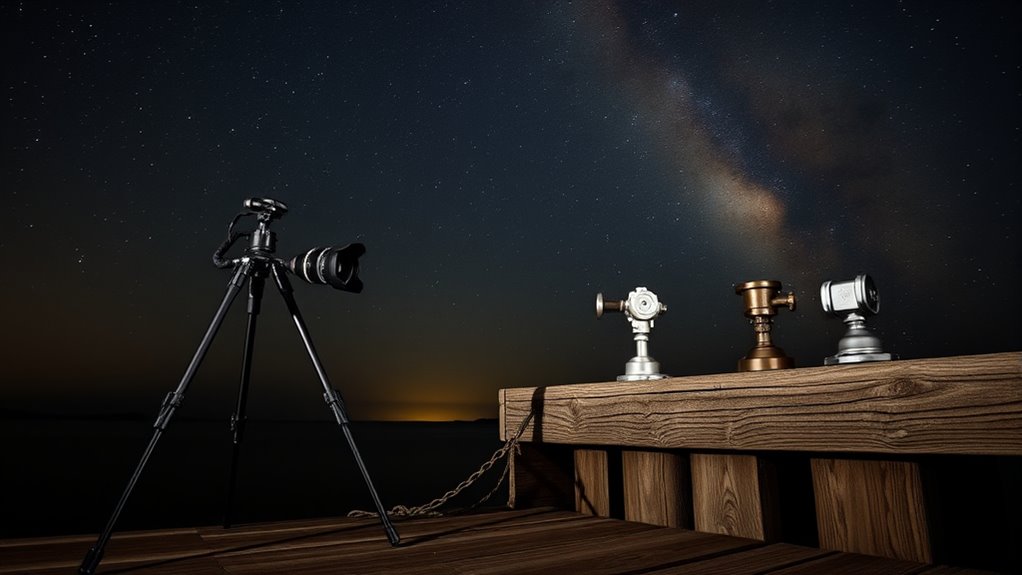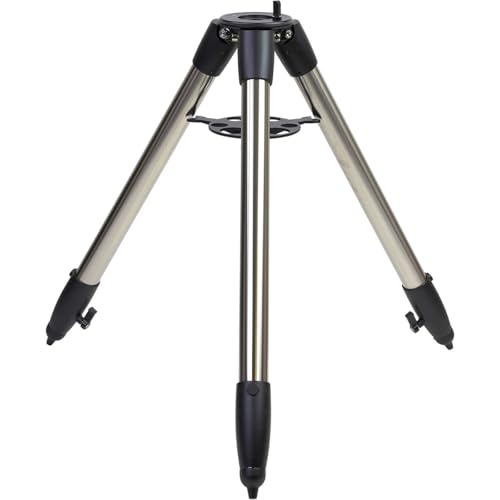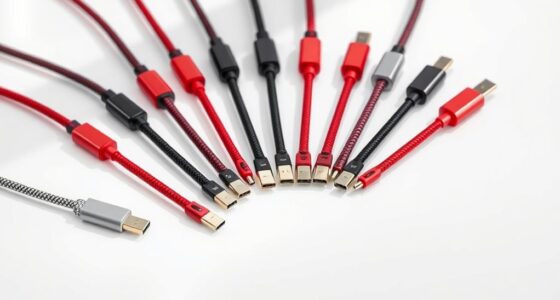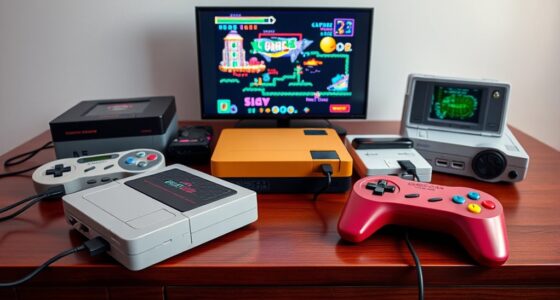If you’re looking to elevate your astrophotography, I recommend checking out lightweight options like the Vortex Optics Mountain Pass Tripod Kit or the Sky Watcher Star Adventurer Tripod for stability and portability. For heavier setups, the iOptron Tri-Pier or EQ6 Tripod offer sturdy support and flexibility. Portable mounts like the Sky-Watcher AZ-GTI and GTI Mount Kit are great for travel and quick setups. Continue on to discover more tips to optimize your sky shots.
Key Takeaways
- Lightweight, portable tripods like the Sky Watcher Star Adventurer and NEEWER monopod support outdoor astrophotography with adjustable heights and terrain adaptability.
- Heavy-duty support systems such as iOptron Tri-Pier and EQ6 tripods provide stability for large telescopes and long-exposure astrophotography.
- Pier mounts like the iOptron SkyHunter extension offer elevated sky access and compatibility with various mounts for enhanced imaging.
- Advanced equatorial trackers with PMC-Eight technology deliver precise, vibration-free night sky imaging for serious astrophotographers.
- Mounts with integrated Wi-Fi, GoTo, and stability features, such as the Sky-Watcher Star Adventurer GTI, facilitate easy setup and high-quality night sky shots.
Vortex Optics Mountain Pass Tripod Kit
The Vortex Optics Mountain Pass Tripod Kit is an excellent choice for outdoor enthusiasts who need a lightweight, durable, and versatile support system. I find it perfect for birding, wildlife watching, or capturing nature shots. Weighing just 3.6 pounds, it’s easy to carry and set up in the field. Its adjustable telescoping legs and smooth pan-and-tilt head make positioning effortless, even in challenging conditions. Made from machined aluminum, it’s sturdy yet lightweight, supporting loads up to 22 pounds. Whether I’m sitting or lying down, it provides stable, vibration-free shots, making it a reliable companion for outdoor photography or observation.
Best For: outdoor enthusiasts, birders, wildlife watchers, hunters, and nature photographers seeking a lightweight, durable, and versatile tripod support.
Pros:
- Supports loads up to 22 pounds, offering strong stability for various devices
- Compact and lightweight (3.6 pounds), making it highly portable for field use
- Constructed from machined aluminum, ensuring durability and vibration reduction
Cons:
- Quick-release mount lacks a stop or tightness adjustment, which may affect security
- Slightly higher price point compared to some comparable tripods
- Some users report minor issues with sight glass mounting tightness
iOptron Tri-Pier for GoTo Mounts
If you’re seeking a stable, high-capacity support for your GoTo mount, the iOptron Tri-Pier is an excellent choice. Its robust design minimizes vibrations, supporting up to 220 pounds, so you can confidently mount larger telescopes. Despite its strength, it’s portable, weighing just 25.8 pounds and folding down to 12.8 x 26 inches for easy transport. The adjustable height from 31.5 to 42.5 inches ensures comfortable viewing angles, while its terrain compatibility allows stable setup on uneven ground. With a 5.7-inch pier diameter and 150mm top plate, it’s versatile and compatible with various mounts, making it an ideal support for astrophotography sessions.
Best For: amateur astronomers and astrophotographers seeking a stable, portable, and versatile mount support for large telescopes on varied terrains.
Pros:
- Supports up to 220 lbs, accommodating heavy and large telescope setups.
- Lightweight and foldable design, making transportation and setup easy.
- Adjustable height and terrain compatibility ensure comfortable viewing and stable positioning.
Cons:
- May require additional accessories for specific mount compatibilities.
- Larger footprint when fully extended could be less suitable for very tight observation spots.
- Assembly and leveling might be time-consuming for first-time users.
iOptron SkyHunter Extension Pier and Tripod
Looking for a sturdy, versatile support system for your astrophotography setup? The iOptron SkyHunter Extension Pier and Tripod might be just what you need. Made from durable stainless steel and lightweight aluminum, it offers stability without adding too much weight. The tripod fits SkyHunter and other mounts with 3/8-16 or M6 holes, while the 7.5-inch extension pier provides extra height for better sky access. Weighing around 24 pounds, it’s solid enough to support your gear securely. With a sleek design and compatibility with multiple mounts, this support system helps you elevate your night sky shots with confidence.
Best For: astrophotographers and stargazing enthusiasts seeking a durable, stable support system compatible with multiple mounts and cameras.
Pros:
- Made from durable stainless steel and lightweight aluminum for stability and ease of transport
- Compatible with SkyHunter, SkyGuider Pro, SkyTracker Pro, iPano, and mounts with 3/8-16 or M6 holes
- Supports up to 24 pounds, providing solid support for astrophotography equipment
Cons:
- Weighs approximately 24 pounds, which may be heavy for some users to carry or move frequently
- Limited to specific mounts and cameras with compatible mounting holes, reducing versatility with other gear
- Price and availability may vary, and some users might prefer a more portable or adjustable support option
EQ6 Tripod to Wave Steel by Sky-Watcher
For serious astrophotographers seeking stability, the EQ6 Tripod to Wave Steel by Sky-Watcher offers robust support with its 2-inch rolled steel legs that minimize vibrations and guarantee smooth tracking. Its durable construction assures reliable performance during long exposures, making it ideal for detailed astrophotography. The tripod is compatible with Sky-Watcher Wave mounts, including NEQ6, EQ6, EQ6-R, and AZ-EQ6, offering versatile setup options. To attach a Wave Mount securely, you’ll need a Wave Pier Adapter (S30916). With its sleek black trim, it provides both a professional look and sturdy support, elevating your night sky imaging experience.
Best For: serious astrophotographers seeking a stable, durable tripod to support their Sky-Watcher Wave mounts for high-quality imaging and long-exposure astrophotography.
Pros:
- Robust 2-inch rolled steel legs provide exceptional stability and vibration reduction.
- Compatible with multiple Sky-Watcher mounts, including NEQ6, EQ6, EQ6-R, and AZ-EQ6.
- Sleek black trim offers a professional appearance that complements various setups.
Cons:
- Requires a Wave Pier Adapter (S30916) for secure attachment, adding an extra component.
- Heavier and potentially less portable due to its durable steel construction.
- May be overbuilt for casual or light-duty observing needs, making it more suited for serious astrophotographers.
Sky Watcher Star Adventurer Tripod
The Sky Watcher Star Adventurer Tripod stands out as an ideal choice for amateur astronomers and astrophotography enthusiasts seeking a lightweight yet durable platform. Its compact size (36 x 54 x 36 inches) and weight of just under 5 pounds make it highly portable, perfect for outdoor adventures. Compatible with a range of mounts and scopes, including the Star Adventurer Mini and GTi series, it offers excellent stability even in windy conditions. The tripod’s adjustable legs and accessory tray with a locking twist provide convenient setup and leveling. Overall, it’s a reliable, versatile support system that balances strength and portability for all your astrophotography needs.
Best For: amateur astronomers and astrophotography enthusiasts seeking a lightweight, sturdy, and portable tripod for outdoor celestial observations and telescope mounting.
Pros:
- Durable and rigid construction supports heavy payloads with minimal flexure
- Lightweight and compact design enhances portability for travel and outdoor use
- Easy to set up, adjust, and level, with a locking accessory tray for added stability
Cons:
- Slight misalignment issues with the accessory tray may occur if not properly installed
- Limited to compatible mounts; may not fit all telescope models or accessories
- Slightly lower height adjustment range compared to larger, more robust tripods
NEEWER Basic 74 Video Tripod Monopod
If you need a versatile and budget-friendly solution for astrophotography or outdoor videography, the NEEWER Basic 74 Video Tripod Monopod stands out as an excellent choice. Made from lightweight yet sturdy aluminum, it weighs just 3.9 pounds and can support up to 17.6 pounds. Its adjustable height ranges from 23.6 to 74.4 inches, perfect for different shooting angles. The 3-way pan-tilt head offers smooth movements, and the inclusion of a phone holder and Bluetooth remote adds convenience for solo creators. Its foldable design, bubble levels, and flexible feet make it practical for uneven terrain, making it ideal for both stationary shots and dynamic filming on the go.
Best For: budget-conscious photographers and videographers seeking a versatile, lightweight tripod and monopod for outdoor, astrophotography, or on-the-go filming.
Pros:
- Lightweight yet sturdy aluminum construction supporting up to 17.6 pounds
- Adjustable height range from 23.6 to 74.4 inches for versatile shooting angles
- Includes convenient features like a 3-way pan-tilt head, phone holder, Bluetooth remote, bubble levels, and flexible feet for uneven terrain
Cons:
- Plastic leg clasps may be less durable over time
- Loose neck swivel can affect stability during adjustments
- Lacks advanced features found in higher-end tripods, such as dual-axis locking or quick-release plates
iEXOS-100-2 PMC-Eight Equatorial Tracker System for Astrophotography
The iEXOS-100-2 PMC-Eight Equatorial Tracker System stands out with its advanced eight-CPU architecture, making it ideal for serious astrophotographers who demand top-tier responsiveness and accuracy. This system’s integrated PMC-Eight technology delivers fast, precise tracking by using eight independent processors, ensuring smooth motion and reducing vibrations. Its mechanical design features clutched dual-axis worm gears and quiet stepper motor belt drives, providing effortless balancing and smooth operation. With built-in polar alignment aids and compatibility with the ExploreStars app, setup becomes quick and straightforward. Supporting WiFi and Bluetooth, it offers seamless control and data transfer, making it a reliable choice for capturing sharp, detailed night sky images.
Best For: serious amateur and professional astrophotographers seeking high-precision, reliable tracking and quick setup for detailed night sky imaging.
Pros:
- Advanced eight-CPU architecture for superior responsiveness and accuracy
- Mechanical design with clutched dual-axis worm gears and quiet stepper motor drives for smooth operation and effortless balancing
- Built-in polar alignment aids and compatibility with the ExploreStars app for quick, precise setup
Cons:
- May be more complex and costly for casual or beginner astronomers
- Requires compatible devices and app setup, which could involve a learning curve
- Heavier or larger than simpler trackers, potentially impacting portability
Sky-Watcher Star Adventurer GTI Mount Kit with Accessories
For astrophotographers seeking a portable and reliable mount, the Sky-Watcher Star Adventurer GTI Mount Kit stands out thanks to its built-in Wi-Fi and full GoTo capabilities. It’s lightweight, easy to set up, and offers precise targeting with a built-in illuminated polar scope. Compatible with DSLR, mirrorless cameras, and small telescopes, it supports multiple tracking rates and unguided exposures up to three minutes. The kit includes a sturdy tripod, pier extension, and accessories for versatile use. Its smartphone control via Wi-Fi simplifies alignment and tracking, making it an excellent choice for travel, beginners, or anyone needing a compact, reliable astrophotography mount.
Best For: beginner and advanced astrophotographers seeking a portable, reliable mount with full GoTo capabilities and Wi-Fi control for capturing celestial objects with DSLR, mirrorless cameras, or small telescopes.
Pros:
- Easy to set up and operate, ideal for travel and beginners
- Built-in Wi-Fi with smartphone app control simplifies alignment and target acquisition
- Supports long unguided and guided exposures, suitable for deep-sky imaging
Cons:
- Polar scope cover and battery compartment design could be improved for durability
- Slightly heavier and larger than previous models, impacting portability for some users
- Limited payload capacity (11 pounds) may restrict larger or heavier accessories
iOptron Mini Pier Tripod Extension
The iOptron Mini Pier Tripod Extension is an ideal upgrade for astrophotographers seeking added stability and height, especially when working with GOTO mounts like the CEM60, iEQ45, and MiniTower series. It elevates your setup by about 8 inches, providing better viewing angles, obstruction clearance, and mounting flexibility. Made from durable materials, it offers a solid foundation that minimizes vibrations, enhancing image quality. While assembly can be tricky due to small screws and hole alignment issues, once properly installed, it’s sturdy and weather-resistant. This extension is a practical accessory for those wanting improved stability and height in their astrophotography rig.
Best For: amateur and professional astrophotographers seeking increased stability, elevation, and flexibility for GOTO mounts like CEM60, iEQ45, and MiniTower series.
Pros:
- Provides an additional 8 inches of height for better viewing angles and obstruction clearance
- Made from durable, weather-resistant materials ensuring longevity in outdoor conditions
- Enhances stability by reducing vibrations, leading to clearer images and observations
Cons:
- Assembly can be challenging due to small screws and hole alignment issues
- Lacks included instructions, requiring users to seek online guidance or prior experience
- Small mounting screws may cause concerns about weight distribution and overall stability
Sky-Watcher AZ-GTI Portable GoTo Alt-Az Mount
If you’re looking for a lightweight, portable mount that offers accurate Go-To capabilities, the Sky-Watcher AZ-GTI Portable GoTo Alt-Az Mount is an excellent choice. Weighing just 8.6 pounds, it supports payloads up to 11 pounds and features durable brass and aluminum gears for smooth tracking. Its adjustable aluminum tripod extends from 28 to 53 inches, and it connects easily via WiFi to the SynScan Pro app on your smartphone or tablet. Perfect for travel, it fits into carry-on luggage. With reliable tracking, simple alignment, and compatibility with lightweight cameras and telescopes, it’s ideal for casual astronomy, astrophotography, and EAA.
Best For: amateur astronomers and astrophotographers seeking a lightweight, portable mount with reliable Go-To capabilities for casual observing and light astrophotography.
Pros:
- Compact and lightweight design weighing only 8.6 pounds for easy portability
- Supports payloads up to 11 pounds, suitable for lightweight telescopes and cameras
- Durable construction with brass and aluminum gears ensures smooth, precise tracking
Cons:
- WiFi connectivity can sometimes be challenging or unreliable
- Slight gear slop and internal gear noise during high-speed slewing
- Mounting a polar scope for astrophotography can be difficult and may require additional accessories
Factors to Consider When Choosing Tripods and Pier Mounts for Astrophotography
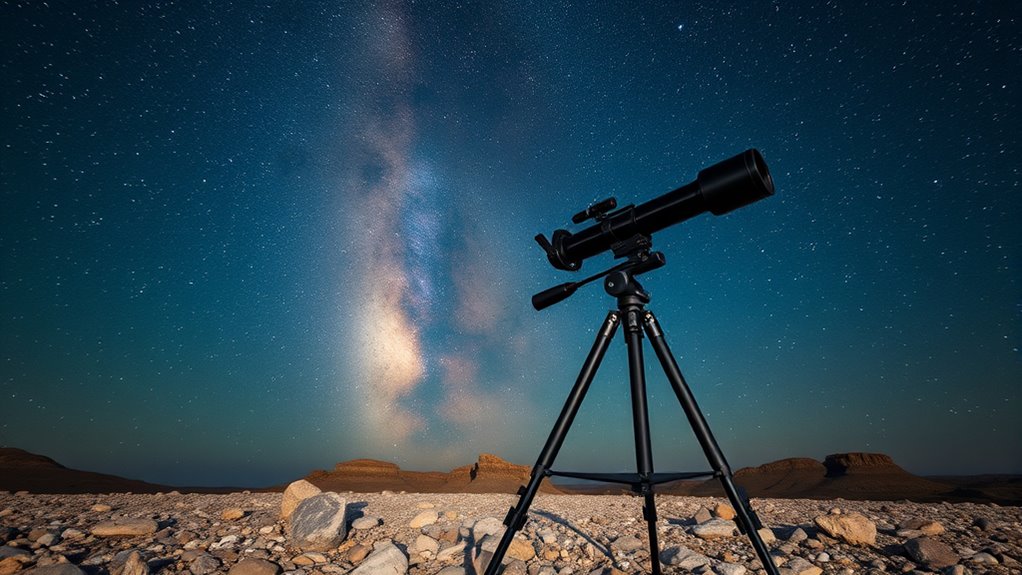
When choosing a tripod or pier mount for astrophotography, I focus on stability and vibration control to guarantee clear images. I also consider how much the setup weighs and how easy it is to carry, especially for outdoor shoots. Finally, I check if the equipment is compatible with my gear and suited to the terrain I’ll be working on.
Stability and Vibration Control
Choosing a stable tripod or pier mount is essential for capturing sharp astrophotography images, especially during long exposures. A sturdy mount minimizes vibrations that can blur your shots, ensuring crisp details in the night sky. High-quality materials like machined aluminum or steel provide greater rigidity and less flexure than cheaper plastic or lightweight options, which is crucial for stability. Independent leg adjustments and locking mechanisms help maintain balance on uneven terrain, preventing wobble or shifts during imaging. Adding a center hook or weight hook allows you to add ballast, damping vibrations caused by wind or movement. Vibration suppression can be further improved with damping pads, vibration isolation plates, or by ensuring your mount is perfectly balanced before shooting. These factors are vital to achieving clear, sharp astrophotography results.
Weight and Portability
Considering the importance of portability in astrophotography, selecting a tripod or pier mount that balances weight and stability is key. Lighter models are much easier to transport and set up in remote locations, which is crucial for outdoor sessions. Many lightweight options feature compact or foldable designs, making handling and storage more convenient. However, lighter equipment often sacrifices some stability, so it’s important to consider load capacity and build quality to prevent vibrations. Heavier tripods tend to offer better stability and vibration damping but can be cumbersome to carry over long distances or rough terrain. Ultimately, the right choice depends on your specific needs—whether you prioritize easy transport or maximum stability—and how often and where you plan to observe or shoot.
Compatibility With Equipment
Ensuring your tripod or pier mount is compatible with your astrophotography equipment is vital for a smooth setup and reliable performance. First, check that mounting holes and thread sizes, like 3/8-16 or M6, match your gear’s connectors. Make sure the load capacity exceeds the combined weight of your telescope, camera, and accessories to keep everything stable during long exposures. Look for mounts supporting quick-release systems such as Arca-Swiss or Vixen, which make attaching and removing gear quick and secure. Additionally, confirm that the mounting platform can handle your equipment’s weight distribution and balance needs. Finally, choose a mount design that allows precise polar alignment and fine adjustments, essential for accurate tracking of celestial objects. Compatibility ensures stable, efficient astrophotography sessions.
Terrain and Setup Ease
When setting up your astrophotography gear outdoors, terrain and setup ease become crucial factors. An adjustable tripod with flexible legs or leveling features makes it easier to stabilize your equipment on uneven ground. A wide footbase or sturdy footing helps prevent tipping, especially on soft or rocky surfaces. Lightweight, portable mounts allow quick assembly and disassembly, perfect for remote locations or spontaneous shoots. Features like a built-in center column hook or adjustable height let you fine-tune stability and angle on diverse surfaces. Easy-to-use locking mechanisms and clear leveling indicators also reduce setup time and frustration in rugged or complex terrains. Prioritizing these aspects ensures your setup remains stable and efficient, so you can focus on capturing stunning night sky images without unnecessary hassle.
Durability and Weather Resistance
Choosing the right tripod or pier mount means paying attention to how well it can withstand outdoor conditions. For astrophotography, durability and weather resistance are essential because you’ll often shoot in rain, snow, or high humidity. I look for equipment made from weather-resistant materials like stainless steel, machined aluminum, or coated steel, which resist corrosion and physical wear. Proper sealing of joints, locks, and moving parts prevents water from seeping in, extending the life of my gear. Durable constructions with rust-proof finishes help maintain stability even in harsh climates. Equipment designed with protective coatings or anodized surfaces ensures resistance to corrosion and scratches. Investing in mounts with reinforced joints and high-quality materials gives me confidence that my setup will perform consistently, no matter the weather conditions.
Frequently Asked Questions
How Do Weather Conditions Affect Tripod Stability During Astrophotography?
Weather conditions definitely impact tripod stability when I’m out astrophotography. Wind can shake my setup, making images blurry, so I use heavier tripods or add weight to stabilize them. Cold temperatures can cause components to contract, affecting balance, while rain or humidity can make surfaces slippery. I always check weather forecasts and bring extra weights or sandbags to guarantee my tripod stays steady, no matter the conditions.
Can Lightweight Tripods Support Long Exposure Astrophotography?
Lightweight tripods are like fragile wings for your camera—they can support long exposure astrophotography if they’re well-designed and stable. I’ve found that choosing a sturdy, high-quality lightweight tripod with good leg locks and dampening features makes a big difference. While they might not be as stable as heavier options, with proper setup and careful handling, they can definitely help you capture stunning night sky shots without weighing you down.
Are There Specific Materials Better for Tripod Durability in Cold Climates?
Yes, materials like magnesium and aluminum are better for tripod durability in cold climates. I prefer magnesium because it’s lightweight yet sturdy, handling freezing temperatures without becoming brittle. Aluminum is also reliable, offering good strength and resistance to cold-induced damage. I always avoid plastics or cheap alloys, as they tend to crack or weaken in low temperatures. Choosing the right material keeps my gear stable and reliable during those chilly night shoots.
How Do I Prevent Vibrations When Using Pier Mounts Outdoors?
To prevent vibrations when using pier mounts outdoors, I make sure to set it on a solid, level surface and use a stable base. I also add weight or sandbags around the mount to absorb any movement. Additionally, I avoid touching the setup during long exposures and use vibration suppression pads if available. These steps help me keep my astrophotography sharp and clear.
What Maintenance Routines Extend the Lifespan of Astrophotography Tripods?
To extend my astrophotography tripod’s lifespan, I regularly clean and lubricate the joints with a silicone spray, especially after outdoor shoots. For instance, after a rainy night, I wipe down the legs and apply lubricant to prevent rust and corrosion. I also check for loose screws and tighten them. Consistent maintenance keeps my tripod stable and guarantees it performs reliably for many more celestial captures.
Conclusion
Did you know that a stable tripod can improve astrophotography shots by up to 50%? Choosing the right mount or pier can truly elevate your night sky photos. Whether you’re a beginner or a seasoned astronomer, investing in quality gear makes all the difference. So take your time, consider your needs, and get ready to capture stunning celestial images. Your perfect setup is out there—happy shooting under the stars!
